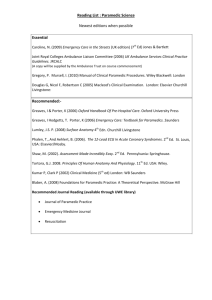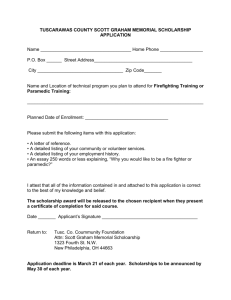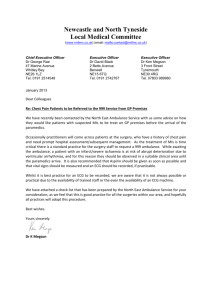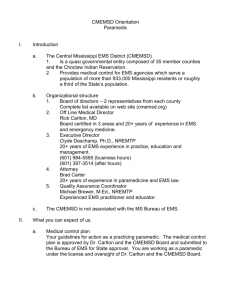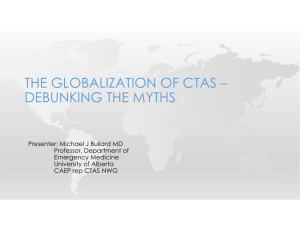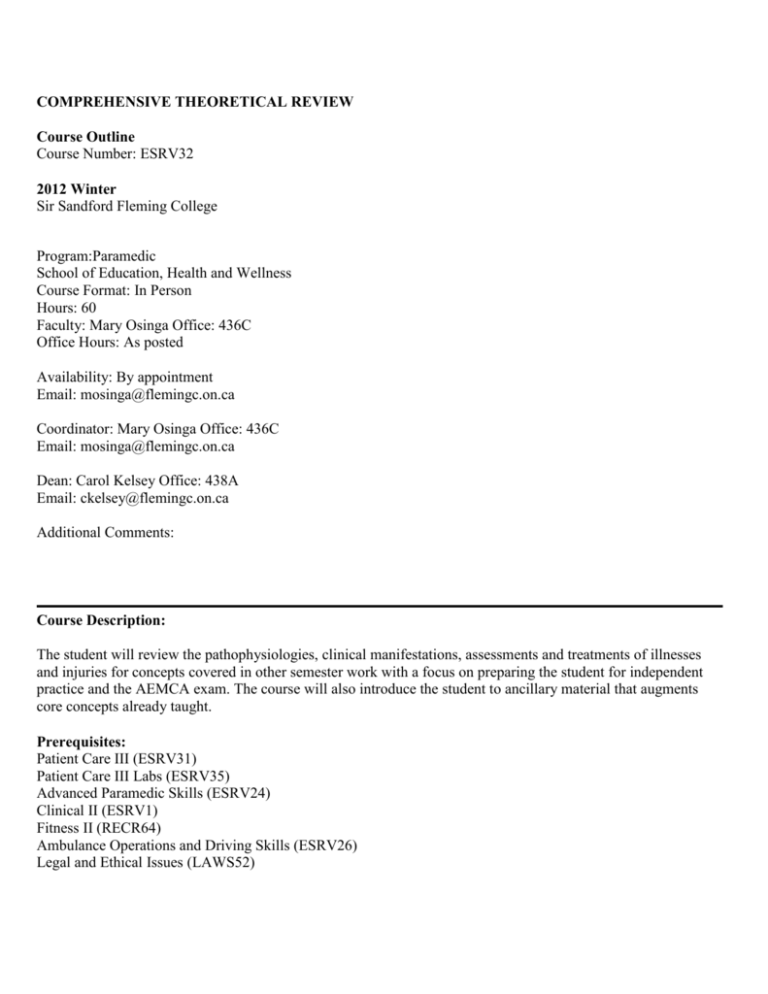
COMPREHENSIVE THEORETICAL REVIEW
Course Outline
Course Number: ESRV32
2012 Winter
Sir Sandford Fleming College
Program:Paramedic
School of Education, Health and Wellness
Course Format: In Person
Hours: 60
Faculty: Mary Osinga Office: 436C
Office Hours: As posted
Availability: By appointment
Email: mosinga@flemingc.on.ca
Coordinator: Mary Osinga Office: 436C
Email: mosinga@flemingc.on.ca
Dean: Carol Kelsey Office: 438A
Email: ckelsey@flemingc.on.ca
Additional Comments:
Course Description:
The student will review the pathophysiologies, clinical manifestations, assessments and treatments of illnesses
and injuries for concepts covered in other semester work with a focus on preparing the student for independent
practice and the AEMCA exam. The course will also introduce the student to ancillary material that augments
core concepts already taught.
Prerequisites:
Patient Care III (ESRV31)
Patient Care III Labs (ESRV35)
Advanced Paramedic Skills (ESRV24)
Clinical II (ESRV1)
Fitness II (RECR64)
Ambulance Operations and Driving Skills (ESRV26)
Legal and Ethical Issues (LAWS52)
Corequisites:
Paramedic Consolidation(ESRV3)
Comprehensive Lab Review(ESRV36)
Crisis Management(SOCI14)
This course contributes to the following learning outcomes or essential knowledge and skills required by learners
as defined by Ministry of Training, Colleges and Universities program standards, employers, industry and
professional organizations.
Vocational Outcomes
Core Competencies and Essential Employability Skills
The student has reliably demonstrated the ability to:
1. Communicate clearly, concisely and correctly in the written, spoken, and visual form that fulfills the
purpose and meets the needs of the audience
2. Uses numerical data, mathematical concepts and reasoning to solve problems
3. Analyze, evaluate, and apply relevant information to solve problems and make effective decisions
4. Create novel ideas/practices to enhance personal/professional success; adapt current ideas/practices in
response to emerging needs.
5. Locate, select, organize, and document information using appropriate technology and information
systems; use educational, presentation and information technologies to learn, collaborate, and
communicate.
6. Establish and maintain positive relationships in ways that contribute to the achievement of goals.
7. Manage oneself and one's resources to achieve goals
8. Articulate an understanding of the physical and social environment from the local to the global level;
reflect on one's role and responsibility.
Aim:
To integrate knowledge of pathophysiology, patient care guidelines and standards and an understanding of other
aspects of Paramedicine, in order to prepare for full indpendent practice as a PCP and to write the AEMCA
exam.
Learning Outcomes:
Upon successful completion of this course the learner will be able to:
1. Outline and explain the provincial guidelines for Field Trauma Triage, the Helicopter Utilization guide,
the provincial guidelines for Multi-Casualty Incidents and Stroke Guidelines for advanced stroke care.
2. Explain the CTAS patient triage system via various patient scenarios and be able to allocate a CTAS
score to that scenario.
3. Discuss the recognition, assessment treatment and of the clinical features of various simulated patient
scenarios including but not limited to various trauma injuries, symptom relief, cardiac arrest, multicasualty, obstetrics etc.
4. Choose the appropriate pieces of ambulance or advanced patient care equipment such as (but not limited
to) cardiac monitors, symptom relief medications, IV therapy etc., and perform the appropriate patient
assessment or reassessment using the particular appropriate equipment.
5. Discuss the safe and effective movement of patients using the various stretchers,stair chairs, incubators or
other equipment found in an ambulance in an ergonomically approved manner
6. Set up and operate various pieces of ambulance and patient care equipment in a safe and effective
manner, specifically (but not limited to) multi-casualty kits, safety helmets, incubator restraining systems,
transport ventilator and adjuncts, obstetrical kits, ACP equipment etc.
7. Discuss the appropriate use of continual monitoring via ACR and incident reports, medication tracking
etc for ongoing patient care in various simulated patient scenarios.
8. Outline the differences between ACP and PCP, their roles and responsibilities, the various ACP
medications, equipment and protocols and practices and how the these levels of paramedics interact to
function out in the field
9. Communicate and discuss the formulation of provisional field diagnosis/working assessments using
critical thinking skills and risk/benefit analysis for various simulated patient scenarios, as they pertain to
delegated medical acts and special situations.
10. Discuss an understanding of the prehospital work environment, paramedic professionalism, well being,
injury prevention, ethics and an understanding of the role of the Ontario Paramedic Association and other
stakeholders in the practice of Paramedicine.
11. Discuss an understanding of the New Motorola GMCP Radio and use of various map reading techniques,
UTM identification etc in order to find patient locations and communicate clearly via Radio
Additional Learning Outcomes Comments:
Learning Sequence:
Wks/Hrs
Units
1
2
3
4
5
6
7
Topics, Resources, Learning Activities
Review of Trauma
Trauma Triage Guidelines
Review of Trauma
Trauma Triage Guidelines
Airway and Breathing
Air Ambulance and Trauma Overview
Circulatory and Shock
Burn Patients and the Trauma System
Test 1
Review of Respiratory Disorders
CPAP
Toronto Trip
Radio procedures
Respiratory Disorders
CPAP
Family Day Holiday Monday
Midterm (test 2) Tuesday
Learning Outcomes
Assessment
12,3,4,5,7,8,9,10
Test 1, 2, Final
12,3,4,5,7,8,9,10
Test 1, 2, Final
12,3,4,5,7,8,9,10
Test 1, 2, Final
4,7,8,10
Test 1, 2, Final
2,3,4,5,6,7,9
Test 1, 2, Final
2,3,4,5,6,7,9
Test 2, Final
1,2,3,4,5,6,7,8,9,10,11 Test 2, Final
8
9
10
11
12
13
14
15
Independent Learning Week
Cardiovascular Review
Multicasualty Incident Management (MCI)
Triage
Cardiovascular Review
Ped Canadian Triage Acuity Scale
(CTAS)Review
Cardiovascular Review
Toxicology/Hazmat
Endocrine review
Map Reading
Radio Procedures 202
Immunology Review
Transport ventilator (ATV) and
Communicable Diseases
Incubator Adaptor Deck
Obstetric Review,Pediatrics
Prehospital Research and Practice
Final
1,2,3,4,5,6,7,8,9,10,11 Test 2, Final
2,3,4,5,6,7,9
Final
2,3,4,5,6,7,9
Final
2,3,4,5,6,7,9,11
Final
2,3,4,5,6,7,9
Final
2,3,4,5,6,7,9,10
Final
all
Final
Learning Sequence Additional Comments:
Learning Resources:
Recommended Texts:
Case Studies for Paramedics, Kevin Branch, 2009 pearson, Prentice Hall (excellent AEMCA prep material)
ITLS 7th Edition, John Emory Campbell, Pearson/Prentice Hall, 2012
Essentials of Pathphysiology,3rd Edition; Porth C.W. 2011, Lippincott Williams and Wilkins
Advanced Life Support Patient Standards (June 2011)
The textbook for the paramedic program (Caroline) will be used frequently, with specific references noted in
class.
911 Responding for Life - Jim Whittle, (2002), Prentice Hall
MOH Packages for:
CTAS and Triage
Motorola Radio - GCMP
Air Ambulance Utilization/Student Manual
ACR 2001
Occupational Health and Safety Bulletins
Incubator Retraining/Incubator Adaptor Deck
Assessment Plan:
Item/Date:
Week 5
Monday
Week 9
Monday
Week 15
Monday
Random
Percent:
Description:
30
Test - material up to date.
30
Test - material up to date.
30
Final - all material up to date.
10
Quizzes (2) ITLS and 1 other
Additional Assessment Comments:
A student must achieve 70% overall to obtain a pass in the course.
Prior Learning Assessment and Recognition:
PLAR uses tools to help learners reflect on, identify, articulate and demonstrate past learning which has been
acquired through study, work and other life experiences and which is not recognized through formal transfer of
credit mechanisms.
PLAR Assessment Options:
These include authentic assessment activities designed by faculty. Learners may also be encouraged and
supported to design an individual documentation package that would meet the learning requirements of the
course.
PLAR options and contact for this course:
Initial Contact: Registrar's Office
Mary Osinga, Co-ordinator, Paramedic Program
Exemptions contact for this course:
Mary Osinga, Co-ordinator, Paramedic Program
Academic Responsibilities:
Mutually, faculty and learners will support and adhere to college Academic Regulations and Student Rights and
Responsibilities. In addition, the following guidelines have been developed to support the learning process.
Students are expected to attend and participate in all classes. All skills introduced must be mastered if check
sheets are applicable, they must be completed.
A field trip to Toronto is scheduled as part of the curriculum for this course and must be attended, unless a
student is sick or other valid reason (see academic rules and regulations)
In the event of documented illness, emergency, or death of an immediate family member that prohibits the
student attending a lab class, makeup provisions may be provided. All material covered in this course remains the
responsibility of the student. It will be the responsibility of the student to catch up on work missed in class. All
term work and evaluations must be completed.
Testing:
Tests will be taken up with two weeks of the test and marks returned to the student. Tests will be taken up in
class.
Exams will not remain with the student. A student may see their tests afterwards at any time, following an
appointment with the instructor. A student must achieve 70% overall to obtain a pass in the course.
If the student has any questions or concerns about the grading of any evaluation method, the student must make
an appointment with the professor within one week of the evaluation method being returned, and bring with them
appropriate references from textbooks or notes. (Returned is defined as when the evaluation method is returned to
the class.)
Make-up arrangements for tests are normally not allowed. However, in the event of documented illness,
emergency, or death of an immediate family member that prohibits the student from writing the test, makeup
provisions may be provided. Allowance for make-up arrangements will only be provided if the student
communicates to the faculty member by noon (1200 hrs.) on the day of the scheduled writing. A message may be
left on voice mail or E-mail. The course faculty, in consultation with the appropriate program coordinator, will
determine the eligibility of the student to perform the make up test.
Rescheduled tests must normally be taken within a maximum of three school days from the original scheduled
date. The rescheduled test will not be the same as the one performed by the rest of the class and may have a
different format.
No rescheduled tests will be allowed after tests have been returned to any students.
When long term illness or other circumstances make it impossible for the student to perform the test within the
time frame, the situation will be dealt with on an individual basis. If there are repetitive absences in writing tests
on the scheduled date, the co-coordinator will be notified.
Class Procedure:
Each class period is 50 minutes in length and begins promptly at the scheduled time. Students are expected to be
in class/lab at the scheduled start time and remain there until dismissed.
A ten-minute break will be given between the first and second period of a two-hour class.
Any furniture that is moved must be replaced to the original position upon class completion. It is expected that all
lab equipment will be treated with respect and that students help to clean and replace all lab equipment to the
appropriate storage location.
Academic Behavior:
The student will conduct him/herself in a courteous, responsible manner that is respectful of the other students
and professors. The student is expected to come prepared for and on time for class. Lastness will not be tolerated.
Excessive talking or disruptive behavior will also not be tolerated. It is expected that the student will abide by the
appropriate use of technology policy in the classroom (no cell phones, MP3 players, etc). If personal laptops are
used, ONLY course material will be allowed during class time. If access to other non-related material is found
during class or lab, the student will not be allowed to use the computer in class/lab for the remainder of the term
as this is a distraction for the student and those around them. All material , video content and images on laptop
must be of an academic nature.
Refer to the Student Rights and Responsibilities Document.
Recurrence of behavior deemed detrimental to the best interest of other students and the institution may result in
suspension.
Academic Integrity:
Each student has the responsibility to support academic integrity. Breaches of academic integrity (i.e. cheating)
will result in a grade of zero (0) for the test. All breaches of academic integrity will be reported to the program
co-coordinator, the Dean of Education,Health and Wellness and the Registrar and may result in dismissal from
the program.
Paramedic Program Policies
All paramedic program policies must be adhered to during this course including the uniform policy.

